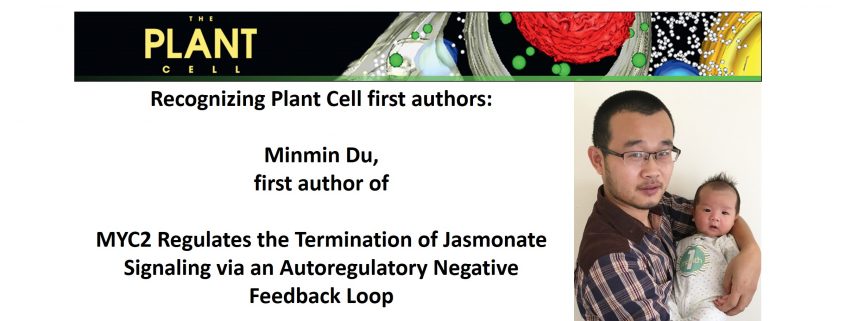Recognizing Plant Cell first authors: Minmin Du
Minmin Du, first author of MYC2 Regulates the Termination of Jasmonate Signaling via an Autoregulatory Negative Feedback Loop
Current Position: Postdoc, Department of Plant & Microbial Biology, University of Minnesota, Twin Cities
Education: PhD, School of Horticulture, Northeast Agricultural University, China
Non-scientific interest: Travelling, David Beckham and Cristiano Ronaldo
Brief bio: I was trained in plant genetics in Prof. Chuanyou Li’s lab at the Institute of Genetics and Developmental Biology, Chinese Academy of Science. I have been focusing on studying MYC2-mediated transcriptional regulation in the Jasmonic acid (JA) pathway in tomato. Using its N-terminal transcriptional regulatory domain, MYC2 could either interact with the transcriptional repressors JAZs to act as a repressive-transcription factor (TF) or interact with the transcriptional activator MED25 to serve as an activating-TF. Given JA can trigger JAZs degradation, the activation of the JA signaling may be considered as the switch of MYC2’s function from a transcriptional repressor to a transcriptional activator.
In this project, we found MYC2’s role as a transcriptional activator is not limited to the activation of the JA signaling, MYC2 also regulates the termination of the JA signaling by activating a small group of MYC2-like bHLH TFs, which are negative regulators of the signaling. These bHLH TFs, termed MTBs, may be evolutively modified versions of MYC2. Similar to MYC2, MTBs can directly bind to the promoters of MYC2 target genes. Different from MYC2, MTBs can only interact with JAZs but cannot interact with MED25, thereby only serving as transcriptional repressors in regulating the expression of MYC2 target genes. Our findings open a new gate for studying the termination of this important signaling pathway. I am now a postdoc in Prof. William Gray’s lab at the University of Minnesota for studying the molecular mechanism of auxin-mediated cell expansion. I am also very interested in plant molecular breeding.
杜敏敏, 第一作者MYC2 Regulates the Termination of Jasmonate Signaling via an Autoregulatory Negative Feedback Loop
目前职位: 美国明尼苏达大学植物与微生物系,博士后
教育经历: 东北农业大学园艺学院,博士
本人简介: 在东北农业大学进行两年的蔬菜遗传育种方面的学习后,本人于2009年开始在中科院遗传所李传友组接受系统的植物分子生物学方面的科研训练。在此期间,主要围绕番茄转录因子MYC2介导的转录调控机制展开研究。作为茉莉酸信号途径中的核心转录因子,MYC2通过其N 末端的转录调控结构域,或者与转录抑制子JAZ互作发挥其转录抑制作用,或者与转录激活子MED25互作行使其转录激活功能。由于JAZ和MED25竞争性地与MYC2互作以及茉莉酸可以诱导JAZ蛋白的降解,因此,茉莉酸信号的激活实际上是MYC2由一个转录抑制因子(与JAZ互作)转化为转录激活因子(与MED25互作)的过程。
在本项研究中,我们发现MYC2作为转录激活因子的意义并不仅限于茉莉酸信号的激活,它还可以通过激活一类与MYC2同源的bHLH 转录因子MTBs的表达对茉莉酸信号进行削减或终止。MTBs在茉莉酸信号途径中发挥负向调控作用。与MYC2类似,MTBs可以直接结合在茉莉酸早期基因(MYC2靶标基因)的启动子上;与MYC2不同的是,MTBs的转录调控结构域只能与JAZ互作而不能与MED25互作,因此只能作为转录抑制因子调控MYC2靶标基因的表达。本项工作为今后研究茉莉酸信号的终止机制指明了方向。2017年至今,本人在美国明尼苏达大学William Gray实验室从事生长素调控细胞伸长相关的研究工作。




